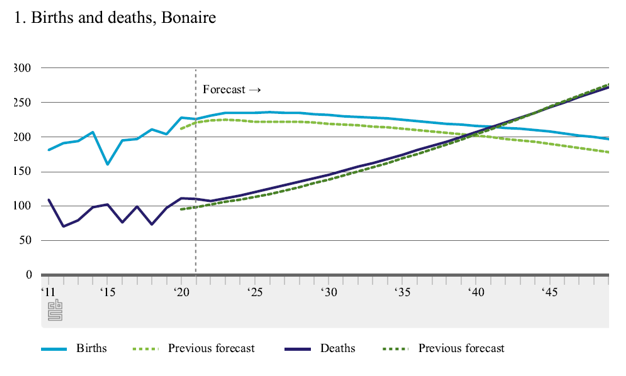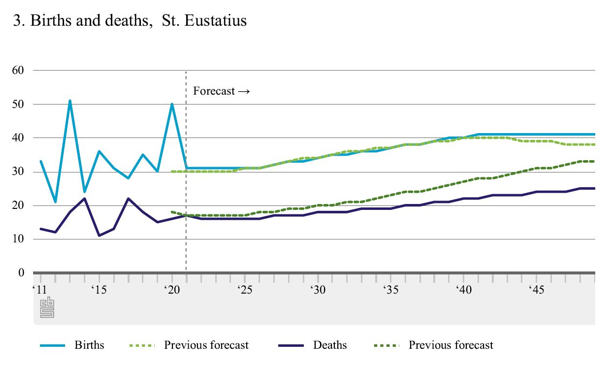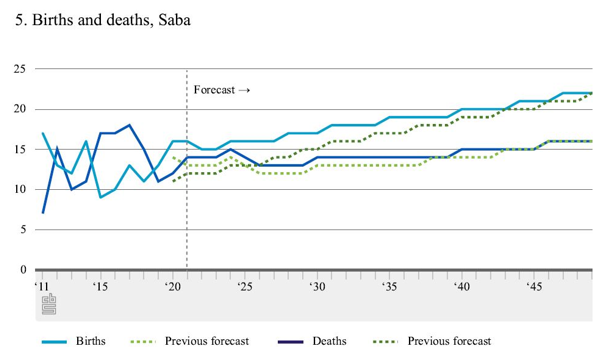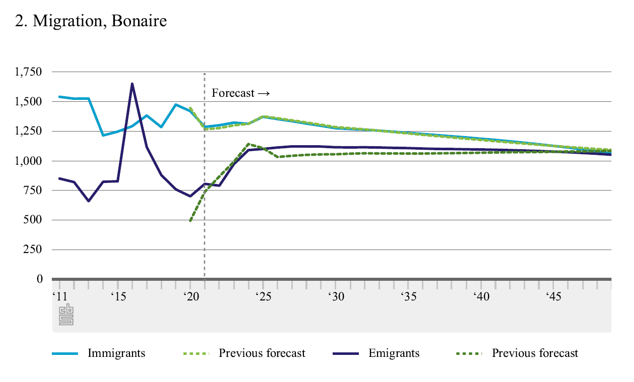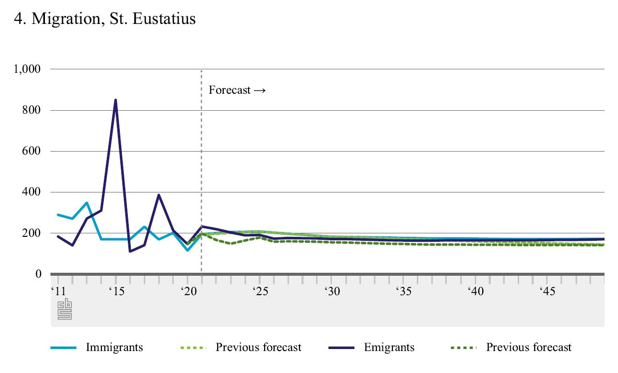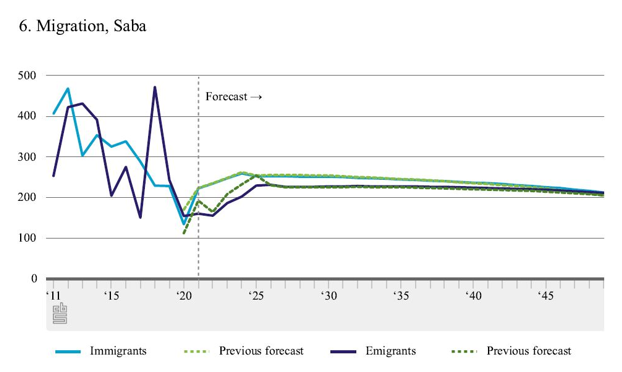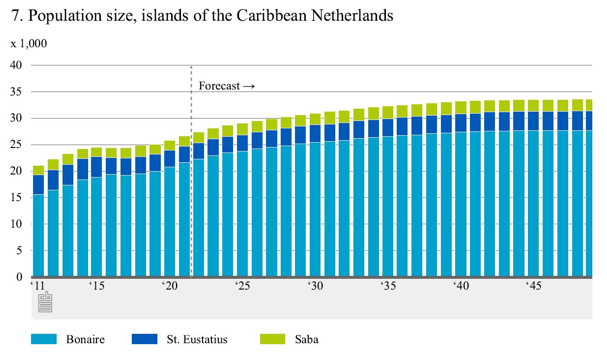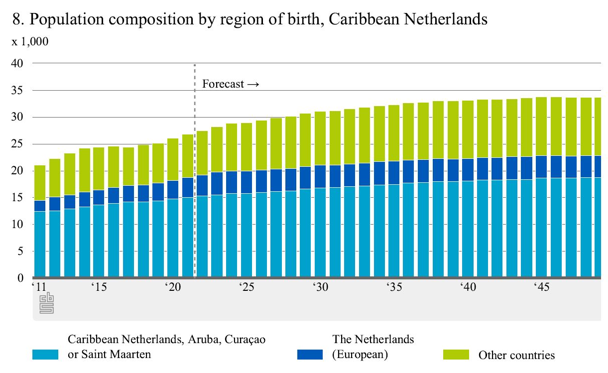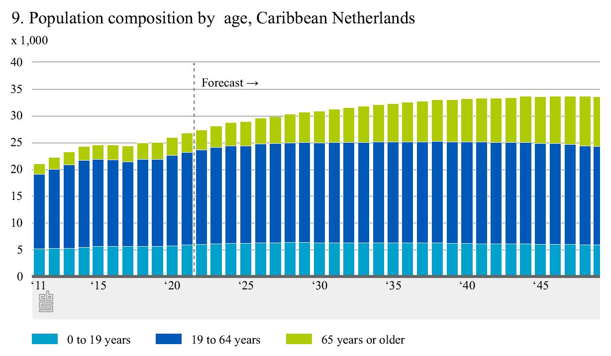Population forecast Caribbean Netherlands 2021-2050
Corina Huisman and Coen van Duin
Statistics Netherlands (CBS) has generated a new population forecast for the municipalities of the Caribbean Netherlands. This memorandum describes the main results and differences relative to the previous forecast of 2020.
This population forecast update includes recent data. This additional information mainly affects the expectations for immigration and emigration. New estimates have been made of the return behaviour of migrants. In the previous forecast these were still based on migration data over the period up to and including 2017, now up to and including 2020. Additionally, the age patterns of immigrants and emigrants have been re-estimated on the basis of these new data.
The new forecast expects a lower ageing rate on the islands than the previous forecast. According to the new forecast, a larger part of the immigrants from the European Netherlands will leave again, as a result of which the proportion of elderly people on the islands will show a lower increase. The population is expected to increase from 27 thousand at present to 31 thousand in 2030. Last year's forecast expected just under 32 thousand residents in 2030.
Migration assumptions, coronavirus
The coronavirus pandemic has been affecting migration figures since March 2020. It seems to have restricted both the emigration of persons born in the Caribbean Netherlands and the immigration of persons born outside the Caribbean Netherlands. Net migration (immigration minus emigration) for 2021 is expected to be approximately 200 lower than it would have been without the pandemic.
It is expected that this decrease will be temporary. It is assumed that the restricting impact of the pandemic on the emigration of persons born in the Caribbean Netherlands will have decreased to approximately one-third by 2023 and will have disappeared by 2024. This is also assumed regarding immigration from the European Netherlands. It is assumed that immigration from other countries outside the former Netherlands Antilles will remain lower for a slightly longer period of time. The economic impact of the pandemic on, for instance, tourism can be more lasting, which may limit the demand for foreign workers. It has been assumed that the restrictive effect on immigration among this group will halve until 2023 and will have disappeared by 2025. It seems that already in 2021, immigration from Aruba, Curaçao and St Maarten will no longer be restricted by the pandemic.
Migration assumptions, longer term
According to the new estimates, a larger part of the immigrants born in the European Netherlands will eventually leave again: 91 percent, versus 75 percent in the forecasts of 2019 and 2020. Immigrants who have already resided in the Caribbean Netherlands for several years, appear to be emigrating after all more often than according to earlier estimates. Also among immigrants from Aruba, Curaçao and St Maarten the revised percentage of people leaving is higher (66 percent instead of 50 percent). For immigrants from other countries, the expectation for the share which will leave again has, on the contrary, been slightly reduced (76 percent instead of 80 percent). The expectation for the proportion of emigrants born in the Caribbean Netherlands who eventually return has also been lowered: from 57 percent to 54 percent.
The age patterns of immigrants and emigrants have changed in recent years and have therefore been re-estimated for this update. In the forecasts of 2019 and 2020, data over the years 2011-2017 were used to estimate these patterns, which now have been updated to 2015-2019. The main revision regarded the emigration age patterns. According to the new estimate, a smaller proportion of the emigrants are in their twenties and a larger proportion are middle-aged or elderly.
Just as in the forecasts of 2019 and 2020, net migration is assumed to be zero as of 2050, so annually as many immigrants as emigrants. Between 2030 and 2050 it is assumed that net migration will gradually decrease to zero.
Mortality assumptions
Since the start of the pandemic, 17 deaths due to coronavirus have been registered in the Caribbean Netherlands (as at 26 July 2021). The 2020 forecast assumed only a limited number of additional deaths due to COVID-19 per annum because of the young population of the islands and because until May 2020 a higher mortality rate was not yet visible. In 2020, the total number of deaths in the Caribbean Netherlands was 19 higher than expected. Also for 2021, it is expected that the mortality rate will be slightly higher due to COVID-19. For the years thereafter, just as in the previous forecast, it is assumed that the mortality risks for residents of the Caribbean Netherlands will decrease at the same pace as for residents of the European Netherlands. For St Eustatius, the number of deaths is expected to be lower in the longer term than in the 2020 forecast. This is due to the revised migration assumptions, as a result of which a smaller rise in the number of elderly persons on the island is expected.
The number of births in the Caribbean Netherlands was 33 higher in 2020 than expected in the forecast. Expectations regarding the final number of children per woman in the Caribbean Netherlands have therefore also been adjusted slightly upwards. For Bonaire and St Eustatius, a larger number of residents aged around 30 is expected in the longer term than in the previous forecast, also resulting in a higher number of births. This is due to the fact that the age patterns of migrants have changed over the past few years, which has been included in the new forecast.
Population forecast
In the period from 1 January 2011 to 1 January 2021, the number of residents in the Caribbean Netherlands rose from 21 thousand to 27 thousand. That comes down to a growth of some two and a half percent per year. The forecast expects a population of 31 thousand in 2030, i.e. a population growth of 1.6 percent per year. In the forecast, growth will come to a halt around 2050. By that time the Caribbean Netherlands are expected to have almost 34 thousand residents.
Of the three islands, Bonaire has shown the strongest population growth since 2011. The forecast also expects the strongest growth for Bonaire: from 22 thousand in early 2021 to 27 thousand in 2030 and 28 thousand in 2050. St Eustatius is expected to grow from 3.1 thousand residents in early 2021 to 3.7 thousand in 2050. Saba is expected to grow from 1.9 thousand to 2.3 thousand residents.
The previous forecast expected a population for Bonaire in 2050 which was approximately 700 higher than according to the new forecast. For St Eustatius, the population in the previous forecast was approximately 200 residents higher, for Saba 100 higher.
The number of residents in the Caribbean Netherlands born there or in one of the islands of Aruba, Curaçao or St Maarten is expected to remain at roughly the current level of 56 percent until 2030. Roughly 14 percent of the residents were born in the European Netherlands and 30 percent elsewhere. This too is expected to remain the same until 2030. In the years thereafter, the proportion of residents born in the former Netherlands Antilles or the European Netherlands will decrease slightly according to the forecast and the proportion of residents born elsewhere will increase by 3 percentage points. In the 2020 forecast, the proportion of European Dutch nationals in 2030 was approximately 2 percentage points higher and the proportion of residents born elsewhere was 2 percentage points lower than in the new forecast.
The population of the Caribbean Netherlands is ageing. At the beginning of 2021, 13 percent of the population of the Caribbean Netherlands were 65 years or older. The proportion of this group will increase according to the forecast. For 2030, 19 percent of the population is expected to comprise people aged 65 and over; for 2050, this is 28 percent. Because according to the new forecast, a larger part of the immigrants from the European Netherlands will leave again, the proportion of elderly people in the new forecast will show a lower increase than in the previous forecast. The 2020 forecast expected that 20 percent of the population would comprise people aged 65 and over in 2030 and 30 percent in 2050.
Sources
Customised table (forecast 2021-2050):
https://www.cbs.nl/nl-nl/maatwerk/2021/31/bevolkingsprognose-caribisch-nederland-2021-2050
Explanatory memorandum (forecast 2020-2050)
https://www.cbs.nl/nl-nl/achtergrond/2020/41/bevolkingsprognose-caribisch-nederland-2020-2050
Customised table (forecast 2020-2050):
https://www.cbs.nl/nl-nl/maatwerk/2020/41/bevolkingsprognose-caribisch-nederland-2020-2050
Article containing a more detailed description (forecast 2019-2050):
https://www.cbs.nl/nl-nl/achtergrond/2019/31/bevolkingsprognose-caribisch-nederland-2019-2050
